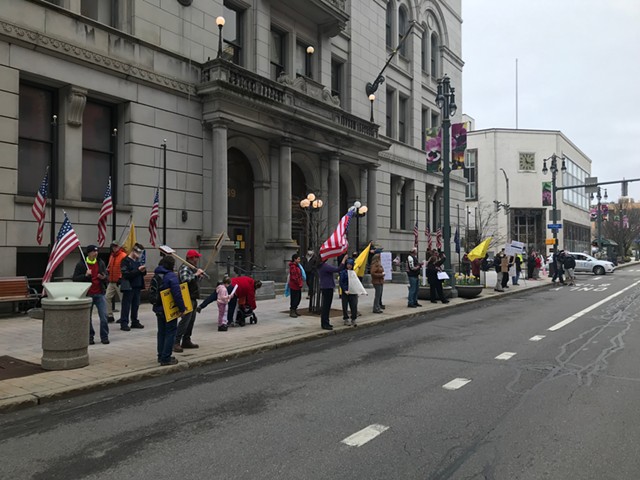A few dozen proudly defiant demonstrators waving American flags and signs gathered outside the Monroe County Office Building in downtown Rochester on Friday to condemn state orders keeping most businesses closed during the pandemic.
The cure of shutting down the economy, they said, was worse than the disease — that being the novel coronavirus that has sickened 1,400 people locally and killed more than 18,000 people across the state, including 121 in the county.
Behind the protesters, many with unmasked faces, a string of flags ringing the building flew at half-staff in remembrance of the dead. In front of them, on Main Street, a string of cars, trucks, and mini-vans ringed the block and honked their horns in solidarity with each passing loop.  One of the demonstrators was Tom Antinora, 55, of Penfield. He wore a face mask and held aloft a sign that read, “I Need A Haircut! #FreeUpstate!”
One of the demonstrators was Tom Antinora, 55, of Penfield. He wore a face mask and held aloft a sign that read, “I Need A Haircut! #FreeUpstate!”
Antinora said he understood well how hard the virus has hit New York. But it made little sense to him why businesses in Rochester and across upstate, where the number of cases are so much lower than New York City, and proportionately so, should have to stay closed.
“New York City is a different animal,” he said. “We’re up here and we have needs. I don’t want the cure to be worse than the disease.” 
Although polls show most Americans support restrictions meant to combat the virus, concerns like those of the demonstrators are not uncommon.
In New York, their hopes for a break in the shutdown were raised the other day when Governor Andrew Cuomo announced that construction and manufacturing jobs could start up again on May 15.
But the hope ended there.
On Friday afternoon, after the demonstration had died down, Bob Duffy, the head of the Greater Rochester Chamber of Commerce and Cuomo’s former lieutenant governor, said at news conference that the next phase of opening the economy was anyone’s guess.
“We literally have no idea,” he said.
Anyone could be forgiven for being frustrated by the update. Who doesn’t want America to reopen and daily life to return to normal?
But imagine for a moment that the restrictions on businesses were lifted tomorrow. How eager would people be to embrace normalcy? Some might venture out for a haircut, perhaps. But how many would go to a movie? Or the gym? Or a happy hour?
Mario Zelaya has some first-hand experience with those questions. He runs a popular chain of 40 bars called Bad Axe Throwing, where patrons drink and throw axes. One outlet is on East Avenue in Rochester. Another is in Atlanta, where the governor of Georgia opened the state a week ago.
“It was a disaster,” Zelaya said.
Zelaya has a background in marketing Fortune 500 companies. Prior to Georgia reopening, he managed to get Bad Axe mentioned on CNN and in the Atlanta media, and used the platforms to showcase the safety measures being put in place.
He crunched the state’s coronavirus numbers and figured his audience, the under-40 crowd, would be eager to get out. Before the pandemic, the Atlanta location welcomed and average of 600 customers each weekend, he said. Last weekend, two customers showed up.
“That shows me there’s a macroeconomic issue at play,” Zelaya said. “It’s a combination of people maybe not necessarily having enough income to go out, but equally important is people being worried about the virus.”
Given his experience in Atlanta, Zelaya said, he wouldn’t open his location in Rochester tomorrow if given the chance.  One trendy Atlanta bar’s experience is not a litmus test for a successful reopening. But it does offer a cautionary tale — that reopening is not like opening a spigot. It is a stumble start.
One trendy Atlanta bar’s experience is not a litmus test for a successful reopening. But it does offer a cautionary tale — that reopening is not like opening a spigot. It is a stumble start.
Just ask Jim Staffieri, the owner of the popular local Pizza Stop chain. His location in downtown Rochester was open Friday for walk-ins and takeout. The lunch-hour crowd is often lined up out the door.
That day at noon, even with scores of honking cars circling the block to support restaurants like his being able to open fully, there were three customers inside.
Staffieri described business this way: “It’s okay, for what it is.”
Rhonda Neri, 55, one of the protestors, said she was willing to take her chances contracting the virus because she was at the end of her rope. “Right now, I’m depending on food cupboards to get food,” she said. 
Neri, of Rochester, explained that the weekly hours she had working at a local restaurant have been cut to six from 25 and that she hasn’t been able to collect unemployment because, like thousands of people, she can’t get through to the state Labor Department to register.
“I understand it’s not safe, but I need to get back to work,” Neri said. “There’s ways to be safe and be working by wearing masks and putting barriers in between customers and keeping the restaurant at 25 percent capacity.”
If only the restaurants that were open could hit such a number.
The cure of shutting down the economy, they said, was worse than the disease — that being the novel coronavirus that has sickened 1,400 people locally and killed more than 18,000 people across the state, including 121 in the county.
Behind the protesters, many with unmasked faces, a string of flags ringing the building flew at half-staff in remembrance of the dead. In front of them, on Main Street, a string of cars, trucks, and mini-vans ringed the block and honked their horns in solidarity with each passing loop.

- PHOTO BY DAVID ANDREATTA
- A few dozen demonstrators gathered outside the Monroe County Office Building on Friday, May 1, 2020, to call for businesses to reopen amid the coronavirus pandemic.
Antinora said he understood well how hard the virus has hit New York. But it made little sense to him why businesses in Rochester and across upstate, where the number of cases are so much lower than New York City, and proportionately so, should have to stay closed.
“New York City is a different animal,” he said. “We’re up here and we have needs. I don’t want the cure to be worse than the disease.”

- PHOTO BY DAVID ANDREATTA
- Tom Antinora, of Penfield, was among a few dozen demonstrators calling for businesses to reopen amid the coronavirus pandemic on Friday, May 1, 2020.
Although polls show most Americans support restrictions meant to combat the virus, concerns like those of the demonstrators are not uncommon.
In New York, their hopes for a break in the shutdown were raised the other day when Governor Andrew Cuomo announced that construction and manufacturing jobs could start up again on May 15.
But the hope ended there.
On Friday afternoon, after the demonstration had died down, Bob Duffy, the head of the Greater Rochester Chamber of Commerce and Cuomo’s former lieutenant governor, said at news conference that the next phase of opening the economy was anyone’s guess.
“We literally have no idea,” he said.
Anyone could be forgiven for being frustrated by the update. Who doesn’t want America to reopen and daily life to return to normal?
But imagine for a moment that the restrictions on businesses were lifted tomorrow. How eager would people be to embrace normalcy? Some might venture out for a haircut, perhaps. But how many would go to a movie? Or the gym? Or a happy hour?
Mario Zelaya has some first-hand experience with those questions. He runs a popular chain of 40 bars called Bad Axe Throwing, where patrons drink and throw axes. One outlet is on East Avenue in Rochester. Another is in Atlanta, where the governor of Georgia opened the state a week ago.
“It was a disaster,” Zelaya said.
Zelaya has a background in marketing Fortune 500 companies. Prior to Georgia reopening, he managed to get Bad Axe mentioned on CNN and in the Atlanta media, and used the platforms to showcase the safety measures being put in place.
He crunched the state’s coronavirus numbers and figured his audience, the under-40 crowd, would be eager to get out. Before the pandemic, the Atlanta location welcomed and average of 600 customers each weekend, he said. Last weekend, two customers showed up.
“That shows me there’s a macroeconomic issue at play,” Zelaya said. “It’s a combination of people maybe not necessarily having enough income to go out, but equally important is people being worried about the virus.”
Given his experience in Atlanta, Zelaya said, he wouldn’t open his location in Rochester tomorrow if given the chance.

- PROVIDED PHOTO
- Bad Axe Throwing on East Avenue in Rochester before the pandemic.
Just ask Jim Staffieri, the owner of the popular local Pizza Stop chain. His location in downtown Rochester was open Friday for walk-ins and takeout. The lunch-hour crowd is often lined up out the door.
That day at noon, even with scores of honking cars circling the block to support restaurants like his being able to open fully, there were three customers inside.
Staffieri described business this way: “It’s okay, for what it is.”
Rhonda Neri, 55, one of the protestors, said she was willing to take her chances contracting the virus because she was at the end of her rope. “Right now, I’m depending on food cupboards to get food,” she said.

- PHOTO BY DAVID ANDREATTA
- Protesters outside the Monroe County Office Building on Friday, May 1, 2020, calling for businesses to reopen amid the coronavirus pandemic.
Neri, of Rochester, explained that the weekly hours she had working at a local restaurant have been cut to six from 25 and that she hasn’t been able to collect unemployment because, like thousands of people, she can’t get through to the state Labor Department to register.
“I understand it’s not safe, but I need to get back to work,” Neri said. “There’s ways to be safe and be working by wearing masks and putting barriers in between customers and keeping the restaurant at 25 percent capacity.”
If only the restaurants that were open could hit such a number.
David Andreatta is CITY's editor. He can be reached at [email protected].